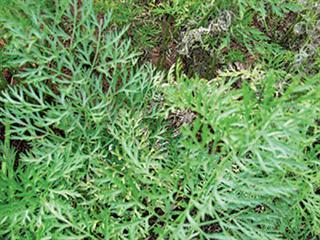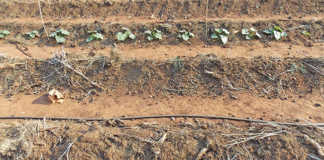
All look similar, so it is important to know which you are dealing with, as control measures may differ. For example, even if the seed has been treated (the Alternaria fungus is seed-borne), there is no guarantee of control, as the product used may be effective on only one of the species.
Alternaria dauci
Damages the foliage by turning the leaves black. This fungus is worse in late summer in summer rainfall areas when the weather cools and there are rainy spells and heavy dew. But it can become a problem whenever the weather is wet. The disease usually starts on the older leaves. First, the edges turn black, followed by the entire leaf. The fungus will then spread to the younger foliage. The petioles will also be girdled.
The spores require free water on the leaf to germinate. If there is heavy dew at night and you irrigate the land early in the morning, you will increase the chances of germination as water will remain on the leaves for a long time. So, as you approach late summer, rather let the leaves dry before irrigating.
Read: Carrot root diseases
Farmers in moist areas, where the fungus is more of a threat, will have to be more careful when choosing a carrot variety, as there are significant differences in susceptibility between varieties. Also, remember that no variety is completely resistant. There are only degrees of resistance. The A dauci spores can remain in the land for several years, which means longer rotations for those who farm in danger areas.
Farmers who have a history of this disease in their carrots should carry out preventative spraying when approaching the high-risk period. It is much easier to prevent this disease from taking hold than to get rid of it once it is established.
Various fungicides will work and copper should be included in the programme. Ask your pest control supplier for advice on what should be applied.
A radicina
Attacks and weakens the stem and root. Can cause a blackening of the carrot shoulder and even black lesions on the root at an advanced stage of development. If infected seed is used and the weather conditions favour the development of the disease, the stem becomes girdled and the plants are easily broken off at ground level.
Years ago, I worked on a farm where a whole land of carrots was wiped out by this pathogen. It was a windy month and all the plants, which were at about the six-leaf stage, were blown away! Being young and inexperienced, I didn’t know about A radicina and assumed that the heat at the time had scorched the plants at ground level. Since then, I have frequently come across farmers who assume that the damage is done by Pythium, a damping off organism that weakens seeds before or after they germinate. They then try to control the damage with the wrong products.
Read: Other carrot problems
The fungus can also strike at a later stage and cause a weakening at the point where the leaves are attached to the root. The leaves then break off easily when a mechanical lifter is used.
A alternata
Seed-borne. Can cause germination problems. Now that hybrid seed has become all but ubiquitous, seed producers are much more aware of the threat posed by this fungus. They therefore go to great lengths to ensure that the farmer will be protected from A alternata (and, indeed, the other pathogens previously mentioned in this column). As a result, the prevalence of this specific disease has greatly diminished in recent years.













